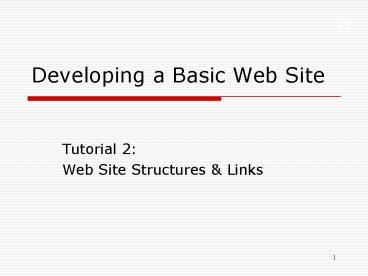Developing a Basic Web Site - PowerPoint PPT Presentation
1 / 23
Title:
Developing a Basic Web Site
Description:
Distinguish between and be able to use absolute and relative pathnames ... Unlike absolute pathnames, a relative pathname does not begin with a slash. ... – PowerPoint PPT presentation
Number of Views:34
Avg rating:3.0/5.0
Title: Developing a Basic Web Site
1
Developing a Basic Web Site
- Tutorial 2
- Web Site Structures Links
2
Tutorial Objectives
- Create hypertext links between elements within a
Web page - Create hypertext links between Web pages
- Review basic Web page structures
- Create hypertext links to Web pages on the
Internet - Distinguish between and be able to use absolute
and relative pathnames - Create hypertext links to various Internet
resources
3
Creating a Hypertext Document
- Hypertext documents contain hypertext links,
items that you can select to view another topic
or document, often called the destination of the
link. - These links can point to
- another section
- the same document
- to a different document
- to a different Web page
- to a variety of other Web objects
4
The browser may only show a portion of the page.
The user must scroll down to see the rest of the
page.
5
(No Transcript)
6
(No Transcript)
7
Linear Structures
8
Augmented Linear Structure
9
Hierarchical Structure
10
Combination of Linear and Hierarchical Structures
11
Linking to a Document
- To create a link to a document, use the same ltagt
tag with the href attribute i.e. lta
hrefcontact.htmgtContact melt/agt. - In order for the browser to be able to locate and
open contact.htm, it must be in the same folder
as the document containing the link.
12
Linking to a Section of a Document
- To navigate to a specific location elsewhere in a
document, rather than the top, you can set
anchors or ids and link to an anchor you create
within the document. - lta hrefhome.htminterestsgt View my interests
lt/agt - the entire text, View my interests, is linked
to the Interests section in the home.htm file,
via the anchor name interests - the pound symbol () in this tag distinguishes
the filename from the anchor name
13
Linking to Documents in Other Folders
- Browsers assume that if no folder information is
given, the file is in the same folder as the
current document. - When referencing a file located in a different
folder than the link tag, you must include the
location, or path, for the file. - HTML supports two kinds of paths absolute paths
and relative paths.
14
Absolute Pathnames
- An absolute pathname provides a precise location
for a file. - With HTML, absolute pathnames begin with a slash
(/) and are followed by a sequence of folders
beginning with the highest level folder and
proceeding to the folder that contains the file. - Each folder is separated by a slash.
- After you type the name of the folder or folders
that contains the file, type a final slash and
then the filename itself i.e. /tutorial.02/case/pa
rks.htm. - HTML also requires you to include the drive
letter followed by a vertical bar () i.e.
/C/tutorial.02/case/parks.htm.
15
Folder Tree
16
Absolute Pathname
17
Relative Pathnames
- A relative path specifies the location for a file
in relation to the folder containing the current
Web document. - As with absolute pathnames, folder names are
separated by slashes. - Unlike absolute pathnames, a relative pathname
does not begin with a slash. - To reference a file in a folder directly above
the current folder in the folder hierarchy,
relative pathnames use two periods (..) i.e.
../tutorial/chem.htm.
18
Relative Pathnames Continued
- Relative pathnames make your hypertext links
portable. - Unlike absolute pathnames, If you move your files
to a different computer or server, the hypertext
links will stay intact. - If absolute pathnames are used, each link has to
be revised. This can be a very tedious process.
19
Relative Pathnames
20
Linking to Documents on the Internet
- A URL specifies a precise location on the Web for
a file. - You can find the URL of a Web page in the
Location or Address box of your browsers
document window. - Once you know a documents URL, you can create a
link to it by adding the URL to the ltagt tag along
with the href attribute in your text file i.e. lta
href http//www.mwu.edu/course/info.htmlgt - Course Informationlt/agt.
21
Displaying Linked Documents in a New Window
- By default, each Web page you open is displayed
in the main browser window, replacing the one you
were viewing last. - To force a document to appear in a new window,
you would use the target attribute in the href
tag i.e. lta hrefurl targetnew_windowgtHyperte
xtlt/agt - new_window is a name assigned to the new browser
window
22
Linking to File Transfer Protocol (FTP) Servers
- You can create links to other Internet resources,
such as FTP (File Transfer Protocol) servers. - FTP servers can store files that Internet users
can download, or transfer, to their computers - FTP is the communications protocol these file
servers use to transfer information - URLs for FTP servers follow the same format as
those for Web pages, except that they use the FTP
protocol rather than the HTTP protocol i.e. lta
href ftp//ftp.microsoft.comgtMicrosoft FTP
serverlt/agt.
23
Linking to E-mail
- You can identify e-mail addresses as hypertext
links. - when a user clicks the e-mail address, the
browser starts a mail program and automatically
inserts the e-mail address into the To field of
the outgoing message - The URL for an e-mail address is
mailtoe-mail_address. - lta hrefmailtodavis_at_mwu.edugtdavis_at_mwu.edult/agt































